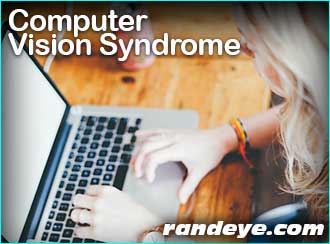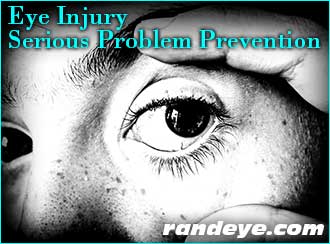Johnny’s No-Flap LASIK Surgery (Part 3) – 1 Week Post-Op
Johnny’s No-Flap LASIK Surgery (Part 3) – 1 Week Post-Op
Johnny’s excited about his new vision and all the activities he will be able to enjoy without contacts or glasses.
Subscribe or Follow Us, to be notified of upcoming episodes.
Computer Vision Syndrome
As more of today’s workforce use computer monitors in the office, more often, workers are experiencing a new type of eye fatigue known as:
Computer Vision Syndrome
While there is no evidence that Computer Vision Syndrome causes any long-term damage to the eyes, regular computer use can be the source of significant eyestrain and discomfort.
If you have Computer Vision Syndrome, you may be experiencing some or all of these symptoms:

- Blurred vision
- Double vision
- Dry, red eyes
- Eye irritation
- Headaches
- Neck or back pain
Untreated, these symptoms can have a real effect on your work performance.
There is a way to relieve Computer Vision Syndrome just by making a few simple changes in your work environment.
Cut the glare
Changing the lighting surrounding your environment can reduce glare on your screen. Consider adding a movable shade to a nearby window. Lower the shade and move the monitor to the side slightly until the glare disappears. You might ask your employer to install a dimmer switch to the overhead lights, or add a desk lamp with a movable shade that distributes light evenly over your workspace. Adding a glare filter over your monitor screen can also help protect your eyes.
Rearrange your workspace
Research shows that the optimal position for your computer monitor is slightly below eye level, or about 20 to 28 inches away from the face. At this position, you should not have to stretch your neck or strain your eyes to see what’s on the screen. Use a copy stand to place any printed materials you may be working from on it so you don’t have to look up and down at the desk while you type.
Give your eyes a break
Look away from the screen every 20 minutes or so, gaze out the window or scan the room for about 20 seconds to rest your eyes to give them a chance to refocus and rest. Blink often to keep your eyes moist. If your eyes are dry, try using sterile lubricating eye drops.
Tweak your computer settings
Try adjusting the brightness, contrast and font size until you find the best settings for your vision. Most writing software programs have a percentage adjustment tab, commonly found at the very top center of your document that allows you to increase the font appearance temporarily and restore it when the document is complete.
Visit your eye doctor regularly for an exam, or schedule a comprehensive eye exam at The Rand Eye Institute. Let the doctor know about eyestrain or any other problems you might be experiencing at work. Call 800-782-1711
Eye Injury Serious Problem Prevention
As many precautions as we take, eye injury accidents do happen.
If you do injure your eye, it is important to know what to do in order to prevent any serious problems from happening.

If you get something in your eye:
- Don’t rub the affected eye. Flush the eye with lots of water and see a doctor if the speck doesn’t wash out, or if pain or redness continues.
Cuts, Punctures, and Foreign Objects in the Eye
- Unlike specks of dust or metal, be sure not to wash out the affected eye. Do not try to remove a foreign object stuck in the eye. Seek immediate medical attention.
Chemical Burns
- Immediately wash the eye with water. Open the eye as wide as possible and continue flushing for at least 15 minutes, even on your way to seeking medical care.
Blows to the Eye
- Apply a cold compress without pressure, or tape crushed ice in a plastic bag to the forehead and allow it to rest gently on the injured eye. Seek immediate medical attention if pain continues, if you have reduced vision, or if blood or discoloration appears in the eye.
This list serves as simple eye safety tips, to prevent further eye problems, and in no way replaces professional emergency medical attention.
You must seek emergency medical care for any and all serious eye injuries.
After Cataract Surgery – amazing results!
Former Fire Dept. Chief J. Mathie talks about his post Cataract Surgery follow-up appointment. “I can’t believe the clarity”, says Mr. Mathie. If you’ve been on the side lines about getting Cataract surgery, don’t hesitate, there’s no better place than the Rand Eye Institute. (Video footage recorded with iPhone 6s in HD)
- Former Fire Chief, J. Mathie
Johnny’s No-Flap LASIK Surgery (Part 2) – 1 Day Post-Op
In this episode Johnny visits the Rand Eye Institute for his 1 day, post No-Flap LASIK surgery, follow-up appointment. Johnny meets with Dr. Allison L. Rand and reviews the details of his surgery.
No-Flap LASIK: 1 Day Post-Op, Johnny’s Follow-up. Coming Soon!
Johnny’s 1 Day Post-Op after No-Flap LASIK surgery video. Coming March 21, 2016. Stay tuned. Subscribe or Follow Us to receive notifications.
Workplace Eye Safety – Common Eye Injuries
There are so many ways you can injure your eyes at work. 
The most common causes for eye injuries are:
• Flying objects
• Tools
• Particles
• Chemicals
• Harmful radiation
Chemical eye burns
Highly acidic and highly alkaline substances are extremely toxic to the eye and can cause chemical eye burns if they come into contact with the surface of the eye.
Alkaline substances pose the greatest risk. These substances are commonly found in workplaces, such as in laboratory chemicals or industrial cleaning products.
Foreign bodies
Small foreign particles such as dust can enter the eye and can cause irritation and inflammation.
Foreign particles such as dust don’t really cause lasting damage to the eyes, but it is very important to remove small particles as to not cause any additional issues.
Blunt trauma
Injuries that do not penetrate the skin and do not result in external bleeding to the eye occur as a result of being struck by a heavy object. They can cause the eye to bleed internally.
Computer use disorders
Using a computer for extended periods of time is associated with a range of temporary eye disorders including pain and discomfort.
Eye diseases associated with excess UV exposure.
Outdoor workers are exposed to ultraviolet radiation in the form of sunlight, excessively. Artificial sources of ultraviolet radiation are also found in a range of workplaces and is also damaging to the eyes. These include welding arcs, germicidal lamps and lasers.
Johnny’s No-Flap LASIK Eye Surgery
Johnny’s No-Flap LASIK Eye Surgery at Rand Eye Institute
Johnny has been approved for No-Flap LASIK eye surgery! After a comprehensive vision evaluation, Johnny is approved for No-Flap LASIK vision correction. After years of wearing glasses he’s finally freed himself from glasses or contacts.
Follow Johnny on the path to his best vision at the Rand Eye Institute. Watch as he experiences No-Flap LASIK Eye Surgery and gets to see clearly without glasses or contacts for the first time in years.
Life With Low Vision
Low vision means that even with regular glasses, contact lenses, medicine or surgery, people may find completing daily tasks they were once comfortable doing, become a great struggle.
Here are some things you can do to help you live more comfortably with Age-Related Macular Degeneration:
Lighting
Good lighting can make a big difference in aiding with vision when it comes to reading a book or knitting.
Having too much or too little light can be dangerous for a person’ with low vision, so it is extremely important to test out different lights and their levels.
Eating The Right Stuff

Eating the right kind of food cannot reverse macular degeneration, but it can help control it or prevent it from developing.
Eat a lot of fruits and vegetables: Antioxidants fight against oxidation, which is a part of the process of AMD. Dark, leafy vegetables like kale, spinach, mustard greens and collard greens are great because they contain lutein, which is a critical antioxidant. Fruits and vegetables are also stock full of antioxidants. Red grapes, peppers, corn, oranges, cantaloupe and mango are great choices.
Eat Fish: People who eat fish 2-3 times a week have a much lower risk of developing AMD, because of the Omega-3.
Control your Fat Intake: Research has shown that the amount of saturated fats consumed in diets is a big problem for people with low vision.
Computers
Computers can help people with low vision with their work, shopping, banking, etc.
Changing the settings on your computer can help with brightness and dimness, font size and much more.
Also, choosing the right pair of glasses is important in working with computers. Distance glasses are designed to focus on objects at 20 feet. Reading glasses are designed to focus at 12 to 16 inches when you look down. Choose glasses that focus specifically on your computer screen. They should also have a filter that will reduce glare.
Driving
Driving with low vision is extremely dangerous and should be avoided at all cost.
If you are having symptoms of age-related Macular Degeneration, schedule a comprehensive eye examination today.
Common Types of Age-Related Macular Degeneration
Dry and Wet Macular Degeneration
Both types destroy the clear, see-straight central vision that is needed for reading, driving, identifying faces, watching television and other daily activities.
Peripheral vision may not be affected. It may also be possible to see side views, in some cases.
Dry AMD
About 90% of AMD cases are classified as dry Age-related Macular Degeneration(AMD).
Usually, AMD starts as the dry type, then can develop in one or both eyes. This process is slow and can advance over several years.
Many people do not even realize they have AMD, because early dry AMD usually has little to absolutely no symptoms.

Three Stages of Dry AMD:
- Early: In this stage, central vision is not affected. People in this stage may develop some small drusen (yellow deposits under the retina), but there is a low risk of it becoming advanced-dry AMD.
- Intermediate: In this stage, both the near and distance vision is affected. A person may have a blind spot or their central vision may be blurred. People with intermediate dry AMD are more likely to have many medium-sized drusen, or one or more large drusen.
- Advanced: In the advanced stage, cells in the macula lose their ability to function completely. A person’s sightline is completely blurred. Over time, vision will most likely worsen and tasks such as reading or recognizing faces becomes extremely difficult. Up to 43 percent of people in this stage of dry AMD will progress to wet AMD, the more aggressive form of the disease.
Wet AMD
Wet Age-Related Macular Degeneration is the most severe form of Age-Related Macular Denegation. Wet AMD can cause a sudden loss of vision within a short period of weeks or months.
In Wet AMD, abnormal blood vessels below the retina grow unexpectedly. These blood vessels break into the macula and cause blood and other fluids to leak.
Once wet AMD is presented in one eye, the chance of it developing in the second is greater.
